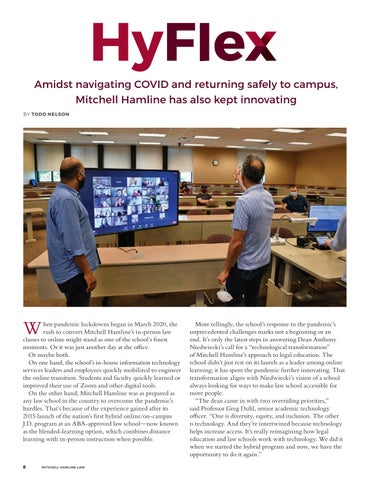Amidst navigating COVID and returning safely to campus, Mitchell Hamline has also kept innovating BY TODD NELSON
Christine Szaj
W
hen pandemic lockdowns began in March 2020, the rush to convert Mitchell Hamline’s in-person law classes to online might stand as one of the school’s finest moments. Or it was just another day at the office. Or maybe both. On one hand, the school’s in-house information technology services leaders and employees quickly mobilized to engineer the online transition. Students and faculty quickly learned or improved their use of Zoom and other digital tools. On the other hand, Mitchell Hamline was as prepared as any law school in the country to overcome the pandemic’s hurdles. That’s because of the experience gained after its 2015 launch of the nation’s first hybrid online/on-campus J.D. program at an ABA-approved law school—now known as the blended-learning option, which combines distance learning with in-person instruction when possible.
8
MITCHELL HAMLINE LAW
More tellingly, the school’s response to the pandemic’s unprecedented challenges marks not a beginning or an end. It’s only the latest steps in answering Dean Anthony Niedwiecki’s call for a “technological transformation” of Mitchell Hamline’s approach to legal education. The school didn’t just rest on its laurels as a leader among online learning; it has spent the pandemic further innovating. That transformation aligns with Niedwiecki’s vision of a school always looking for ways to make law school accessible for more people. “The dean came in with two overriding priorities,” said Professor Greg Duhl, senior academic technology officer. “One is diversity, equity, and inclusion. The other is technology. And they’re intertwined because technology helps increase access. It’s really reimagining how legal education and law schools work with technology. We did it when we started the hybrid program and now, we have the opportunity to do it again.”
